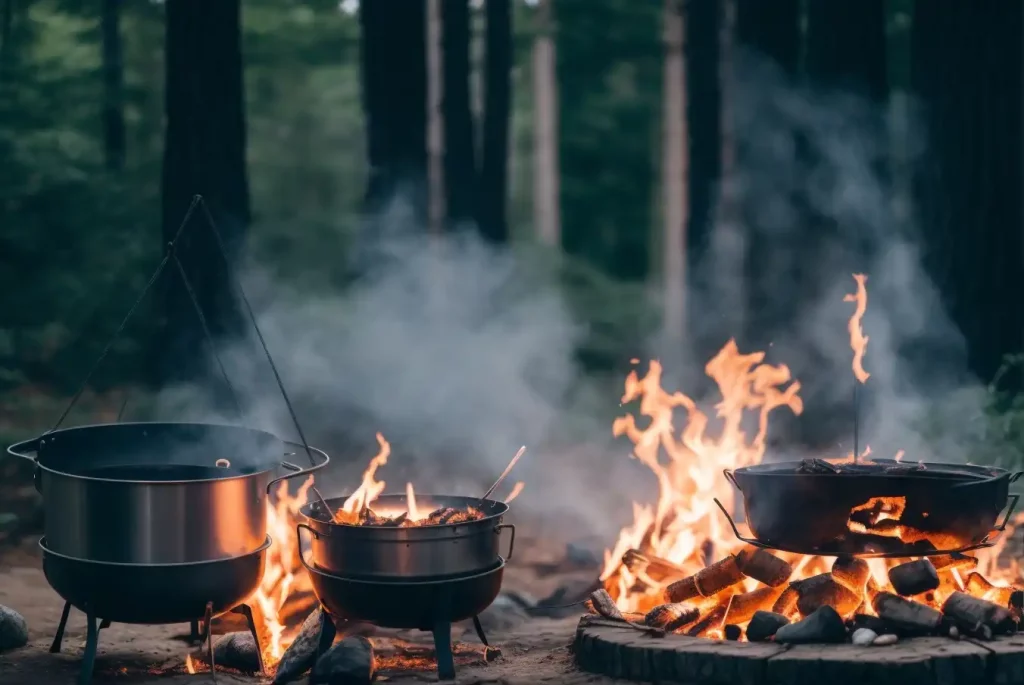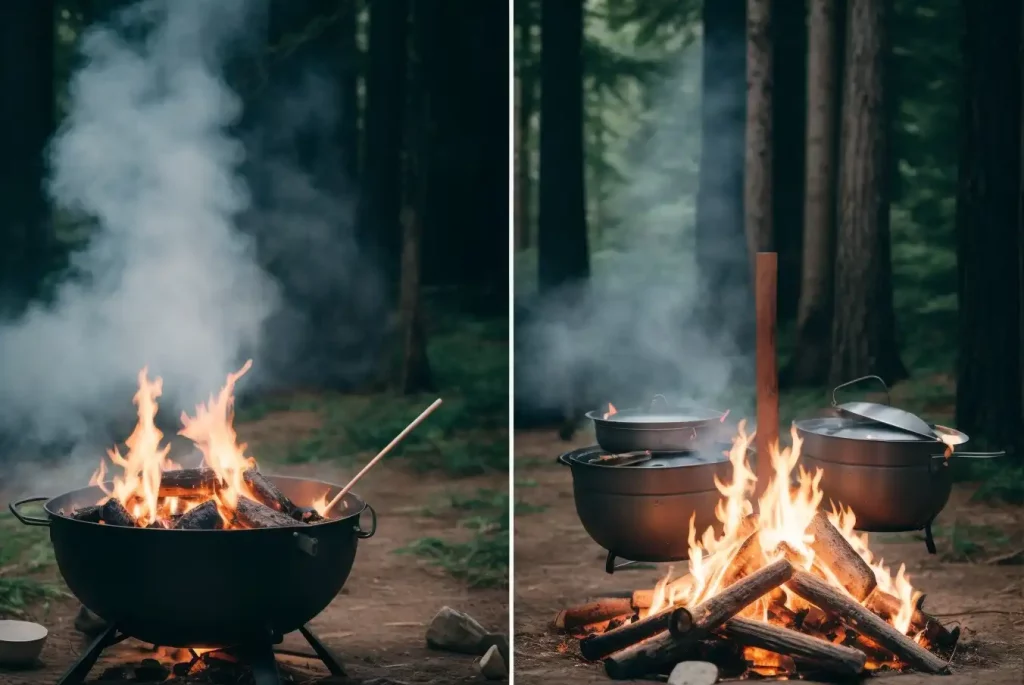Hey there, grillmasters and outdoor enthusiasts! 🌳🔥 Direct vs Indirect Cooking Methods — ever scratched your head trying to decide which is the best for your weekend BBQ?
Look, it’s more than just tossing meat on a grill.
The method you choose can make a world of difference in flavor and texture.
And let’s be real; we all want to be the BBQ hero who saves the day with perfectly grilled steaks, right?
So, let’s dive deep and finally settle the debate between these two classic grilling approaches.
Stick around, and you’ll be a pro in no time!
What is Grilling?
Grilling is the art of cooking food over an open flame, usually at high temperatures.
Now, let’s get something straight. Grilling isn’t just about slapping a burger on some hot metal grates.
It’s a culinary dance, a delicate balance between heat, smoke, and timing.
And one of the most critical steps in this dance is choosing your cooking method.
Importance of Choosing the Right Cooking Method for Grilling
Why does the cooking method matter, you ask?
Well, imagine taking your date out for dinner and serving up a charred piece of what-was-once-meat. Not a great impression, huh?
Each cooking method has its own set of rules and best practices.
For instance, direct grilling will give you that awesome sear we all love, but it’s easy to end up with overcooked or even burnt food.
On the other hand, indirect grilling may take longer but offers you a fool-proof way to achieve evenly cooked meat that’s juicy and tender.
Making the right choice between direct and indirect methods can elevate your grilling game to the next level.
Alright, can’t wait to share more in the next part of this grilling face-off! Stay tuned! 🍖🔥
To know more: Campfire Grilling Techniques

Direct Cooking Method
Alright, let’s jump into the sizzling world of Direct Cooking. 🍔🔥
This method is your go-to for quick, high-heat cooking and it’s pretty much the rock star of the grilling world.
But hey, like any rock star, it has its pros and cons.
So, let’s break it down.
What is Direct Cooking?
Direct cooking is like a hot summer fling—it’s fast, intense, and oh-so-satisfying if done right.
Here, you’re cooking your food directly over the heat source.
Think burgers, thin steaks, and veggies.
Basically, anything that cooks quickly and benefits from a beautiful sear.
Need to know: Safety First: Campfire Grilling Precautions
Advantages of Direct Cooking
Speed
If you’re starving and want that grilled goodness ASAP, direct cooking is your best friend.
It’s quick, often only needing a few minutes per side.
So, if you’re aiming to please a crowd in record time, this method has got your back.
Searing Capabilities
Ah, that mouth-watering sear that locks in all the flavors. 🤤
Direct cooking gives you that high heat you need for a perfect crust.
It creates a flavorful barrier that’ll have your guests begging for your “secret.”
Flavors and Textures
The high heat not only sears the food but also caramelizes the natural sugars, enhancing flavors and adding a bit of that “grilled” texture we all know and love.
Disadvantages of Direct Cooking
Risk of Burning
High heat can be a double-edged sword.
It’s easy to get caught up in the moment and before you know it, you’ve got a piece of charcoal instead of a steak.
Yeah, that’s not the kind of “well-done” anyone wants.
May Not Be Ideal for Thicker Cuts
If you’re dealing with a big, thick cut of meat, direct cooking might leave you with a burnt exterior and an undercooked center.
It’s like wearing a tuxedo to a beach party—just doesn’t work.
Tips for Direct Cooking
Preheating the Grill
First things first, always preheat your grill.
A hot grill ensures that your food cooks evenly and reduces the risk of sticking.
Patience, my friend, it’s worth it!
Cooking Times
For most foods, you’re looking at about 4-6 minutes per side.
But don’t just wing it; invest in a meat thermometer and save yourself from the guessing game.
Flipping Techniques
One flip is usually enough.
Trust the process and resist the urge to poke, prod, or constantly flip your food.
Each flip releases juices and those juices are flavor you don’t want to lose.
Alright, folks, let’s put a pin in it for now.
We’ve dissected the ins and outs of direct cooking, but there’s another contender in the ring—Indirect Cooking.
Stay tuned to find out more! 🍗🔥
Indirect Cooking Method
Ready to venture into the chill vibes of Indirect Cooking? 🍖🔥
This method is like that reliable friend who always has your back.
It’s perfect for when you’re not in a rush and are willing to let things marinate—literally.
So let’s dive in and unravel the mystery of this cooking approach.
What is Indirect Cooking?
Indirect cooking is the slow jam of the grilling playlist. 🎵
You’re cooking the food adjacent to, not directly over, the heat source.
Think big roasts, whole birds, or that rack of ribs you’ve been saving for a special occasion.
Advantages of Indirect Cooking
Lower Risk of Burning
With indirect cooking, the odds of turning dinner into a charcoal sculpture significantly drop.
The heat is gentle, even, and way more forgiving.
Ideal if you’ve got a million other things to do, like perfecting that homemade BBQ sauce.
Ideal for Larger, Thicker Cuts
Got a big ol’ piece of meat to cook?
Indirect cooking lets you play the long game, cooking things through without torching the outside.
This method is your ticket to juicy, tender goodness.
Versatility
You’re not just limited to meat, folks.
With indirect cooking, you can grill pizzas, bake bread, or even whip up some dessert on the grill.
That’s right—dessert!
It’s the Swiss Army knife of grilling methods.
Disadvantages of Indirect Cooking
Takes Longer
While direct cooking is a sprint, indirect is a marathon.
You might need to keep an eye on things for an hour or more.
But hey, good things take time, right?
May Lack a Sear
Since the heat is lower, getting that picturesque sear can be a bit more challenging.
So, if you’re all about that crust, you might want to give it a quick sear on high heat before going the indirect route.
Tips for Indirect Cooking
Using a Two-Zone Setup
Create two zones on your grill—one for direct heat and the other for indirect.
This lets you sear your food first and then move it to the indirect side to finish cooking.
It’s like getting the best of both worlds.
Cooking Times and Temperatures
Patience is key here.
Cooking times can range from 30 minutes to several hours, depending on what you’re grilling.
Keep a grill thermometer handy and maintain a consistent temperature to ensure even cooking.
Alright, there you have it!
The ins and outs of indirect cooking are no longer a secret.
Comparing Direct and Indirect Cooking Methods
Alright, folks, now that we’ve gone through the individual merits of both direct and indirect cooking, let’s pit them against each other! 🥊
It’s time for the ultimate grilling showdown: Speed vs. Depth, Sear vs. Low-and-slow, Direct vs. Indirect.
Speed and Convenience
Direct Cooking
If you’re short on time or just can’t wait to sink your teeth into something tasty, direct cooking is your speed demon.
We’re talking 10-20 minutes, tops.
It’s like the fast food of grilling, but oh-so-much better.
Indirect Cooking
On the flip side, indirect cooking asks for a bit of a time commitment.
We’re talking 30 minutes to even a couple of hours.
This is your Sunday afternoon, radio-on, beer-in-hand kind of grilling.
The wait is a bit longer, but the depth of flavor? Worth it.
Flavor and Texture
Direct Cooking
When you’re cooking directly over the flames, you’re locking in those natural juices and getting an unbeatable sear.
That crispy crust on a steak or those grill marks on your veggies?
Direct cooking delivers that in spades.
Indirect Cooking
Indirect cooking is like a spa day for your meat, letting the flavors meld and deepen.
It gives you that melt-in-the-mouth tenderness that’s hard to achieve with faster methods.
Plus, the risk of burning is way down, so you can experiment more with sauces and rubs.
Versatility
Direct Cooking
Ideal for burgers, steaks, and anything you can cook quickly.
Direct cooking is like that versatile little black dress you can’t go wrong with.
It’s not ideal for thicker cuts, but you can’t beat it for a quick weeknight dinner.
Indirect Cooking
Want to roast a whole chicken? Bake a pizza? Smoke some ribs?
Indirect cooking is your go-to for more complex dishes.
It’s like the multi-tool of the grilling world—ready for anything you throw its way.
FAQs about Direct vs Indirect Cooking Methods
What is indirect cooking method?
Indirect cooking involves heating food without placing it directly over the heat source, usually by creating a heat barrier like a foil or using a two-zone fire in grilling.
What is an example of indirect cooking?
Roasting a turkey in an oven is a classic example of indirect cooking, as the heat circulates around the food rather than directly cooking it.
What is the difference between direct and indirect heating methods?
Direct heating involves placing the food right over the heat source for quick cooking, while indirect heating cooks the food away from the heat, allowing for slower, more even cooking.
What is an example of direct cooking?
Searing a steak on a hot skillet provides direct heat to quickly cook the meat.
What is direct cooking method?
Direct cooking is a method where the food is placed directly over the heat source, such as grilling a burger over open flames.
What is the difference between direct and indirect steaming?
Direct steaming exposes the food directly to steam, usually by placing it in a steaming basket over boiling water. Indirect steaming involves sealing the food in a pouch or foil before steaming, which traps flavors and moisture but doesn’t expose the food directly to steam.
Conclusion
So there you have it, the ultimate grilling face-off.
Direct cooking gives you speed and that unbeatable sear, while indirect cooking offers depth of flavor and versatility.
If you’re just starting out, why not try both?
Use direct cooking for those days when you’re short on time, and save indirect cooking for weekend adventures.
Get a grill with adjustable heat zones, and you’ll be a master of both in no time!
Stay smoky, grill enthusiasts! 🍖🔥


